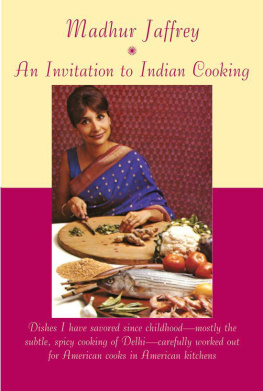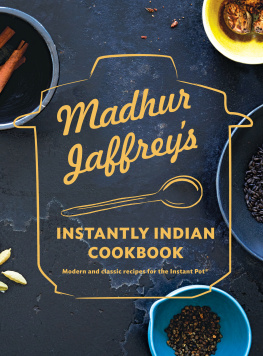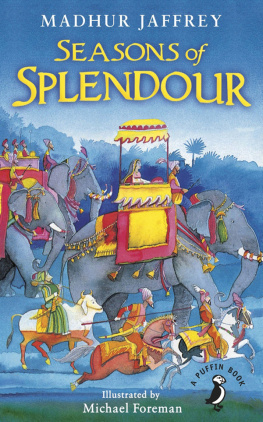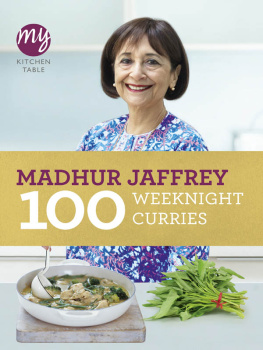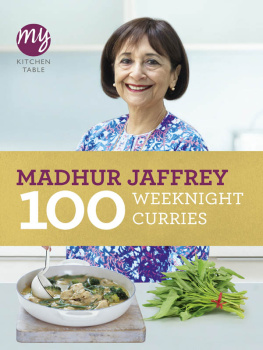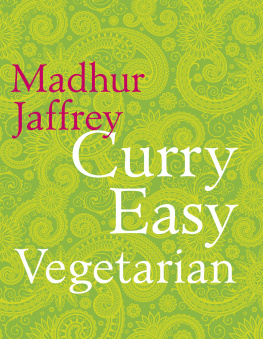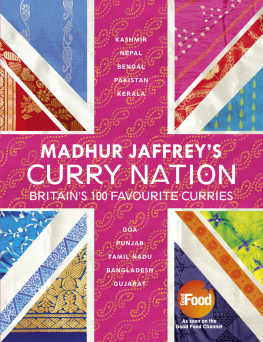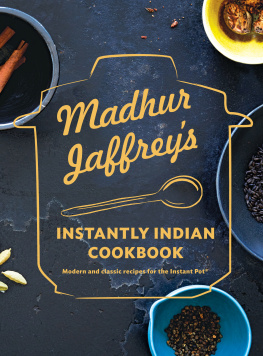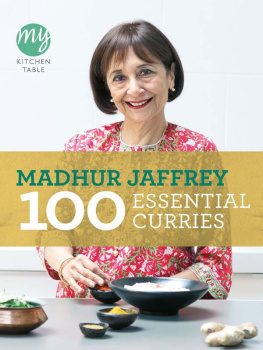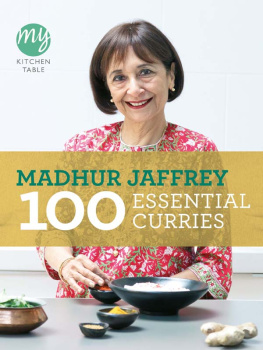Madhur Jaffrey - An Invitation to Indian Cooking (Vintage)
Here you can read online Madhur Jaffrey - An Invitation to Indian Cooking (Vintage) full text of the book (entire story) in english for free. Download pdf and epub, get meaning, cover and reviews about this ebook. year: 2011, publisher: Knopf, genre: Home and family. Description of the work, (preface) as well as reviews are available. Best literature library LitArk.com created for fans of good reading and offers a wide selection of genres:
Romance novel
Science fiction
Adventure
Detective
Science
History
Home and family
Prose
Art
Politics
Computer
Non-fiction
Religion
Business
Children
Humor
Choose a favorite category and find really read worthwhile books. Enjoy immersion in the world of imagination, feel the emotions of the characters or learn something new for yourself, make an fascinating discovery.
- Book:An Invitation to Indian Cooking (Vintage)
- Author:
- Publisher:Knopf
- Genre:
- Year:2011
- Rating:3 / 5
- Favourites:Add to favourites
- Your mark:
- 60
- 1
- 2
- 3
- 4
- 5
An Invitation to Indian Cooking (Vintage): summary, description and annotation
We offer to read an annotation, description, summary or preface (depends on what the author of the book "An Invitation to Indian Cooking (Vintage)" wrote himself). If you haven't found the necessary information about the book — write in the comments, we will try to find it.
An Invitation to Indian Cooking (Vintage) — read online for free the complete book (whole text) full work
Below is the text of the book, divided by pages. System saving the place of the last page read, allows you to conveniently read the book "An Invitation to Indian Cooking (Vintage)" online for free, without having to search again every time where you left off. Put a bookmark, and you can go to the page where you finished reading at any time.
Font size:
Interval:
Bookmark:


THIS IS A BORZOI BOOK
PUBLISHED BY ALFRED A. KNOPF
Copyright 1973 by Madhur Jaffrey
All rights reserved. Published in the United States by Alfred A. Knopf, a division of Random House, Inc., New York, and in Canada by Random House of Canada Limited, Toronto. Previously published in a trade paperback edition by Vintage Books, 1975.
www.aaknopf.com
Knopf, Borzoi Books, and the colophon are registered trademarks of Random House, Inc.
Library of Congress Cataloging-in-Publication Data
Jaffrey, Madhur. An invitation to Indian cooking.
1. Cookery, India. I. Title
TX724.5I4J28 641.5954 72-11023
eISBN: 978-0-307-95785-6
Cover photograph by Irwin Horowitz
Cover design by Carol Devine Carson
v3.1
To
Bauwa and Dadaji
with love
I would like to gratefully acknowledge the help given to me by the followingmy grandmother, whose black lemon pickle opened my taste buds at an early age; my mother, who patiently gave me a two-year correspondence course in cooking; K and Motiboo, for unearthing old family recipes; Hussain, for inspiring me with his endless culinary experiments; V, for finding Indeera; Indeera, for her delicious chutney; Maya, for helping out in moments of panic; Zakiya and John, for willingly eating a lunch composed of five different soups; Ved, for showing such positive approval of a banana relish; Virginia, whose enthusiasm for the book in general and specific recipes in particular kept me buoyed up during the agonizing days of remeasuring and retesting; Zia, Chub (especially Chub), and Mitth, for showing a profound understanding of the chapter system and obligingly eating chicken one month, soups and appetizers the next month, vegetables the following, and so on; Sanford, for saying, You can do it, when I was convinced I couldnt and each batch of a certain sweet dessert was coming out tasting sour; Ismail, for keeping me striving by calling me the second-best cook; Norma and Mrs. S. Matthai, for their expertise in seafood; the Blinkworths, for graciously parting with their recipe for mulligatawny soup before emigrating to Australia; and, most of all, Judith, for her gentle encouragement, unpressured advice, and her very reassuring presence.
This book has been written as a gradual maneuver in self-defense. Let me explain.
You see, I have lived fairly quietly in New York for more than a decade, but in the last few years I have increasingly found myself approached at parties and P.T.A. meetings by a fresh breed of enthusiastic Americans who note my sari and ask, You wouldnt know of a restaurant where we could get some good Indian food, would you? My answer is always an apologetic, I am afraid there is no place in New York or anywhere in America where top-quality Indian food can be foundexcept, of course, in private Indian homes. At this, their faces fall and I begin to feel a familiar upsurge of guilt and patriotic responsibility. I try to explain about the Indian restaurants and refusing to experiment with dishes from their own villages which they perhaps knew much better. The result of all this is that the sauces in such eating places inevitably have the same color, taste, and consistency; the dishes generally come mild, medium, or hot, which is an indication that the food is not being cooked with the spices, as it should be, but that something is being ladled on; appetizers are suggested not because Indians eat them, but because it is felt that Americans cannot do without them.
Naturally, it is difficult to recommend such a restaurant. The only alternative is to invite the people in question home for dinner. I did this for several years, justifying the expense and the effort by telling myself that someone had to let Americans know what authentic Indian food was like and that I couldnt heartlessly ignore their curiosity and interest.
So I kept feeding people in large numbers until exhaustion finally put an end to what I considered was rather discreet proselytizing. A better scheme, as effective as it was cheap, occurred to me. I began writing down the recipes of my most popular dishes and made several copies of them. Whenever someone started a conversation about Indian food, I just handed out a recipe. It worked so well that once when we attended a party, we found that every single dish had been made from my recipes. The hostess, a new acquaintance, was totally unaware of this. In fact, when somebody praised the food and asked her what cookbook she had used, she replied, Well, my dear, these recipes seem to be just floating around. I got them from Edith and she got them from a gal at work. I smiled and said nothing. I was so grateful that Americans were showing such an interest in authentic Indian food and that it wasnt I who was doing the shopping, paying the bills, cooking, and washing up.
I soon found myself mailing recipes to friends in North Brookfield, Massachusetts; Detroit, Michigan; Madison, Wisconsin. I heard from a family in Boston who had loved the marinated butterflied leg of lamband this family included two little children who had been, until then, extremely dubious about all foreign foods.
As the number of Americans cooking from my recipes was getting larger, this cookbook was, slowly and inevitably, taking shape. Now that it is done, my sense of relief is overpowering. For all those people who say they love my food, well, here it is: Indian recipes completely adapted to the American kitchen, some easy and simple, others to be mastered with patience and practice.
I realize that many of you may be cooking Indian food for the first time. I have tried to write the recipes in great detail, describing how the food should look at the end of each major step as well as when it is fully cooked. This may make the recipes a bit long, but dont let that put you off. My intention is merely to lessen the chances for error. Also, dont be discouraged by a long list of spices. Once you have them on your shelf, it is just as easy to sprinkle in five of them as it is to add two.
It may, perhaps, encourage you to know that I myself learned to cook not from observation and practice in our familys kitchen in Delhi but from recipes written on flimsy air-letters, mailed to me by my mother. As a teen-ager growing up in India I was preoccupied with the usual teen-age concernsboys (whom we saw only at a distance and therefore coveted), my ambitions (why cant I play Hamlet?), and other such nonsense. I went into the kitchen only as a dilettante, more to taste than to help or learn.
It was when I was twenty and went to England as a student that I started to learn how to cook. I was extremely homesick, and this homesickness took the form of a longing for Indian food.
The canteen at my drama school served a see-through slice of roast beef accompanied by some watery potatoes and cabbage which no amount of H & B sauce could improve. My limited scholarship funds did not allow me to eat out at the Indian restaurants. So I decided to learn how to cook, and I wrote to my mother in India for recipes. She would answer with long letters in Hindi which I would take with me to school. As I ate my roast and two vegetables, I would ponder her advice put in a pinch of asafetidadont let it burnnow put in the cumin and stir for a second or two add the chopped-up tomatoes and fry my mouth would water and the cabbage would stick in my throat. At this point I couldnt even make tea.
Font size:
Interval:
Bookmark:
Similar books «An Invitation to Indian Cooking (Vintage)»
Look at similar books to An Invitation to Indian Cooking (Vintage). We have selected literature similar in name and meaning in the hope of providing readers with more options to find new, interesting, not yet read works.
Discussion, reviews of the book An Invitation to Indian Cooking (Vintage) and just readers' own opinions. Leave your comments, write what you think about the work, its meaning or the main characters. Specify what exactly you liked and what you didn't like, and why you think so.

